Menu
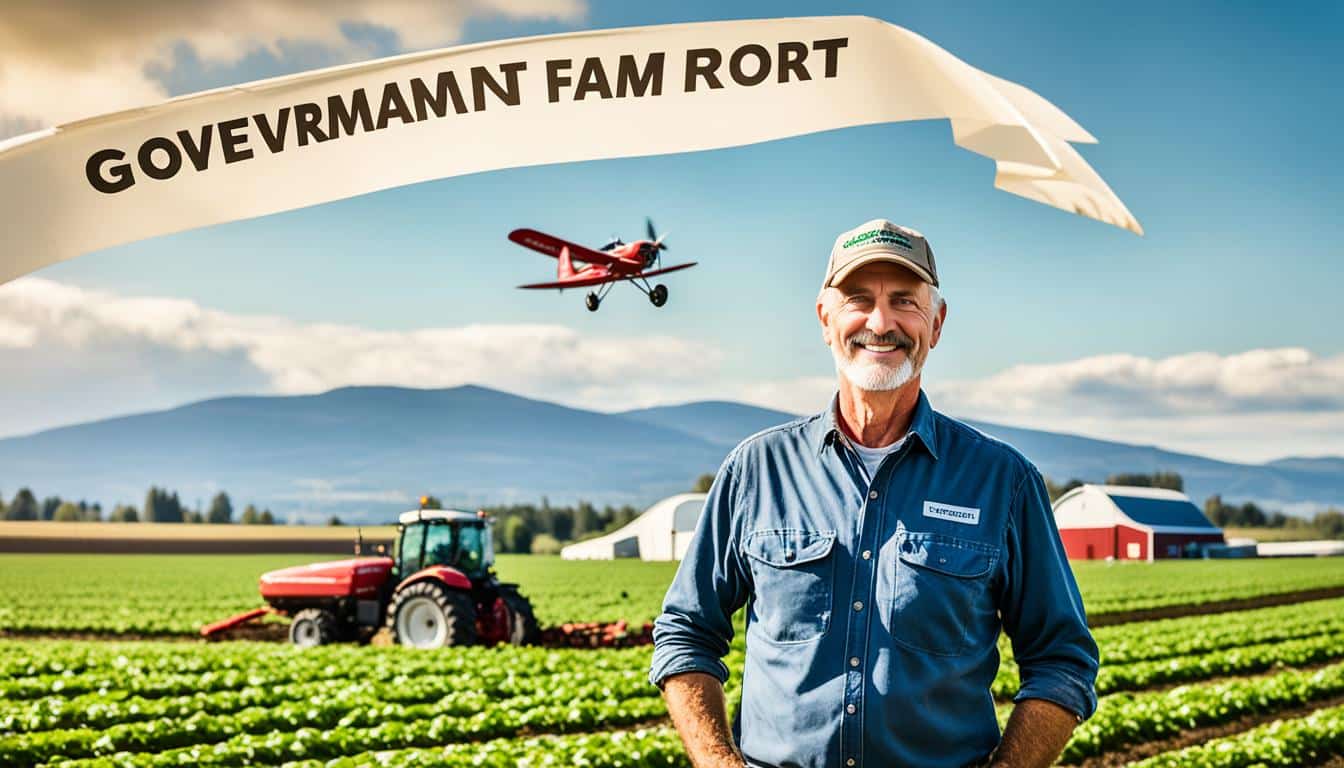
In 2019, farms in the United States got a big $22.6 billion from the government. This was a part of the $111.1 billion net farm income. It shows how vital government help is for farms’ success.
The US government helps farmers in many ways. It offers loans to buy farms or for daily costs. There are also grants for better housing and upgrading rural areas. This support aims to make farming better and more sustainable.
At the heart of this help is the USDA. It works with rural areas to create jobs, push for green energy, and make energy use smarter. This shows a strong government commitment to helping rural places thrive.
Support from the government is key for farmers. It ensures food security and helps in rural growth. Over time, many subsidies and funding methods have been introduced. They aim to keep farms strong and help rural areas to thrive.
Ensuring a steady food supply and strong rural economies is crucial. The government launches programmes like the Farm Storage Facility Loan Program. This and other initiatives offer support to farmers. They provide help in getting equipment and making farm goods ready for sale. This financial aid is vital for the success of many farms.
In the U.S., there’s a long history of helping farmers. Efforts include the Conservation Reserve Program and the EQIP. These aim to protect the land and promote farming. The USDA leads in these efforts, providing help that covers many farming needs. Its work, including programs like the Seasonal High Tunnel Initiative, has a big impact.
| Programme | Support Provided | Impact |
|---|---|---|
| Organic Certification Cost-Share Program | Reimburses up to 75% of certification costs, capped at $750/year | Encourages organic farming by reducing certification expenses |
| Conservation Reserve Program | Provides financial assistance for establishing protective natural borders | Enhances biodiversity and protects the environment |
| Farm Storage Facility Loan Program | Offers low-interest financing for storage and handling equipment | Improves post-harvest handling and storage infrastructure |
| Environmental Quality Incentives Program (EQIP) | Financial and technical support for conservation practices | Promotes sustainable farming and addresses resource concerns |
| Conservation Stewardship Program (CSP) | Payments based on conservation performance | Maintains and improves existing conservation systems |
| Risk Management Agency (RMA) | Federal crop and livestock insurance | Supports producers as part of the farm safety net |
| Value-Added Producer Grants | Funding for processing raw products into consumer-ready items | Increases farmers’ revenue and marketability |
These programs keep evolving to meet farming needs. This shows the ongoing support for farming from the government. It proves the commitment to help farms succeed and ensure the agricultural sector’s growth.
In the United States, farmers get important financial help called agricultural subsidies. These help in many ways, like with direct payments, crop insurance, and programs to boost market opportunities. They aim to make farm incomes more stable and give farmers needed financial safety.
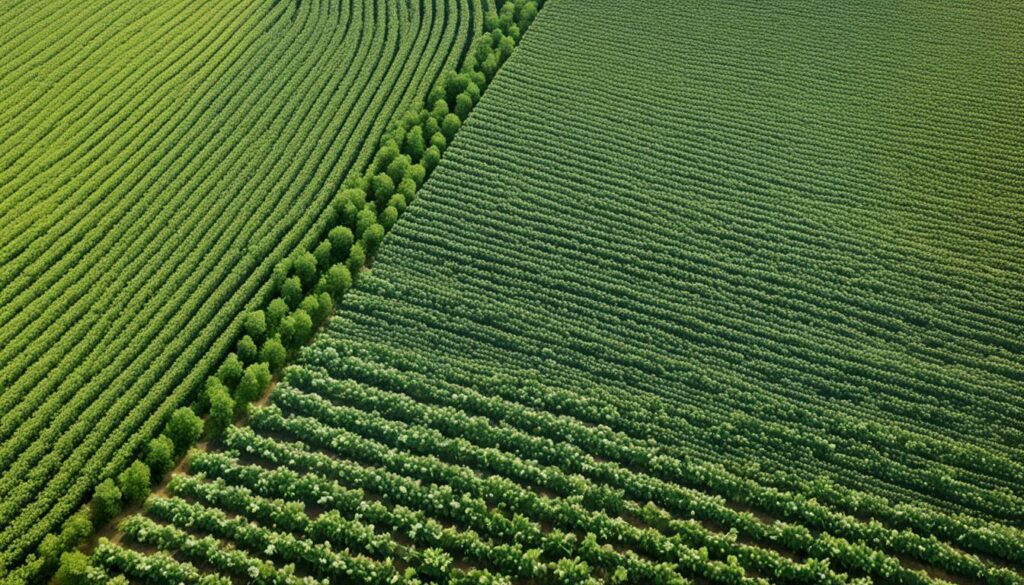
Farmers in the U.S. have different types of support. This support fits their specific needs. The key types are:
The help U.S. farmers get is big, making their income more stable. Farm programs spend about $20 billion a year. For crops like sugar and oilseeds, they can get help equal to a big part of what they produce.
Among global members, countries support farmers by about 31 percent. Some, like Norway and Korea, give even more. But places like Australia and New Zealand give less. The European Union gives about 35 percent support.
In the U.S., grains, oilseeds, cotton, sugar, and dairy receive more help. Other farm goods get less. This support lets farmers invest more securely, making agriculture more productive and sustainable.
So, the U.S. government’s help, like with market programs and crop insurance, is vital. It strengthens the U.S. farm sector.
The government supports farmers by offering farming grants. These grants are for making farms better and ensuring they operate well. The USDA and the Farm Service Agency help through direct and matching grants. An example is the Microloan Program, which since 2013, has given over 8,400 loans. Seventy percent of these loans went to new farmers.
Direct and matching grants are crucial for farm finances. Take the Farm to School grants, for example. Since 2013, they’ve invested nearly $10 million in school food programs. These initiatives support schools buying food locally. Also, the NRCS cost-share program, started in 2010, has helped contract over 10,000 high tunnels. These examples show how important and helpful farming grants are in farming.
The aim is to make applying for grants easy for everyone. The USDA’s Farm Service Agency (FSA) has simplified the process for direct farm ownership loans and FSA loans. This is to help small family farms that can’t get loans from banks. Additionally, the USDA has started projects to help small and mid-sized farmers get GAP certification. This certification helps farmers get more farm improvement funding.
The USDA’s Rural Development programmes have greatly improved living standards and economic growth in rural America. They’ve helped over 17,773 rural businesses, including over 4,200 farmers, since 2013. These efforts have created or kept more than 41,600 jobs, showing a real commitment to rural community development.
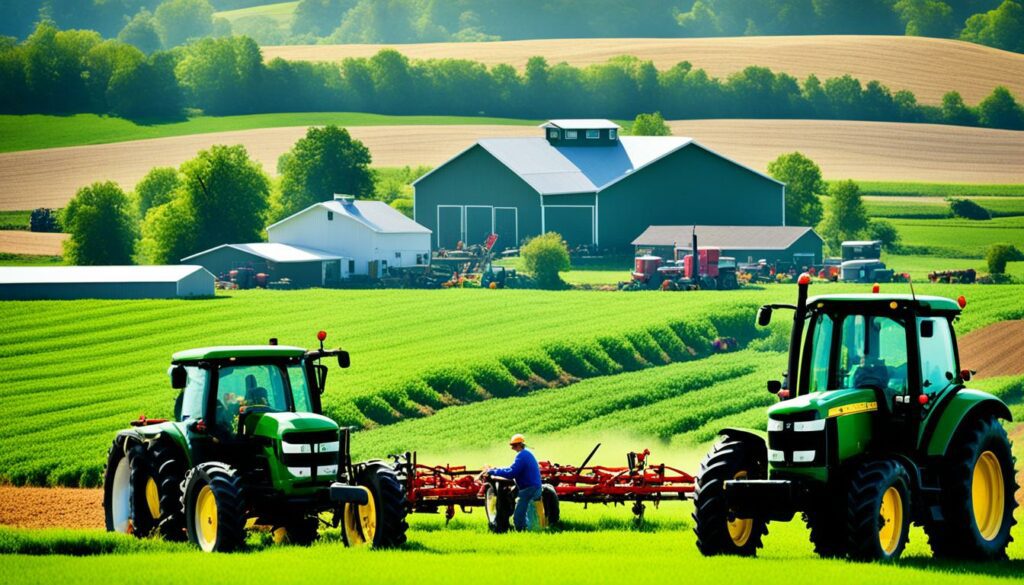
These USDA rural programs also support building homes and community spaces. They make sure important community places get better and stay that way. They also help start renewable energy projects, making rural areas more self-sufficient and green.
A big part of the work is investing in local food systems. Nearly $10 million has gone to Farm to School grants. This money helps schools buy local food, helping the local economy and giving students healthier meals. Also, over 10,000 high tunnels have helped farms grow more food for longer, keeping the food supply steady.
For those just starting in farming, the USDA has given out over 8,400 microloans since 2013. Most of these loans were for new farmers. And in five states, there are projects to help small to mid-sized farms get GAP certification. This helps ensure their food is safe and opens up more selling opportunities.
The USDA also helps rural community development through funding VAPG and SDGG projects. VAPG offers support for farmers to create new products and reach more buyers. And the SDGG gives up to $175,000 to cooperatives, focusing on rural areas with technology help for groups facing hardships.
Altogether, the USDA rural programs show a big effort to move rural America forward. They help build a strong base for the future of these communities.
The US government gives lots of help to farmers through the Farm Service Agency (FSA). This help is to make sure farmers can get what they need to keep going and expanding. It helps them even when times are tough.
The FSA has many loan options. These include direct and guaranteed loans. They help family-size farms and ranches with expenses like operating costs and buying machinery. There’s a special Microloan Program. This one makes it easier for new and small farmers to get needed funds. Since 2013, more than 8,400 of these microloans have been given out, helping lots of new farmers.
| Program | Key Features |
|---|---|
| Organic Certification Cost-Share Program | Reimbursement for up to 75% of certification costs, up to $750 per year |
| Farm Storage Facility Loan Program | Low-interest financing for storage and handling equipment, including refrigerated and mobile storage options |
| Noninsured Crop Disaster Assistance Program | Financial aid for losses of non-insurable crops due to natural disasters, with compensation based on organic market prices |
| Environmental Quality Incentives Program (EQIP) | Financial and technical assistance for implementing conservation practices |
| Conservation Stewardship Program (CSP) | Payments and funding based on conservation performance and priority resource concerns |
To get an FSA loan, farmers must show they can’t easily get a loan elsewhere. The focus is on helping new farmers. Funds are set aside to bring in a new farming generation. Loans can also be taken out using crops that are in storage. This helps farmers cover cash flow needs.
There are also grants available. For example, Value-Added Producer Grants help farmers turn raw products into finished goods. These grants support innovation and new businesses in farming.
Crop insurance subsidies are crucial for farmers. They protect against unpredictable farming risks like bad weather. Administered by the Risk Management Agency (RMA), these subsidies help farmers get insurance from approved providers.

The crop insurance program keeps agriculture stable. It covers more than 60 percent of the insurance cost for farmers. This support is essential during tough times.
In 2022, the program helped with 1.2 million policies. These covered a massive 493 million acres, showing its wide impact.
Most of the help goes to big farms growing large crops. A lot of money, $11.63 billion in 2022, supports these insurance costs. This is an increase from the average of $6 billion each year. But, it also means high costs for taxpayers.
| Year | Total Crop Insurance Subsidy Amount (in billions) |
|---|---|
| Previous Years | Approximately $6 |
| 2022 | $11.63 |
To get crop insurance, farmers should reach out to approved providers. These providers work with the RMA to give out subsidized policies. Although there is no income limit, rules change for farmers making over $900,000 AGI.
If farmers’ AGIs are over $750,000, subsidies might get cut. This could help save taxpayer money, according to Congress.
Changes suggested by the National Sustainable Agriculture Coalition could also make a big difference. If these are acted upon, the changes might save $20 billion over ten years. This would affect only a small percentage of farms.
Agricultural policy assistance is crucial for the farming sector’s resilience. It helps farmers deal with natural disasters and changes in the market. This support aims to keep the agricultural sector sustainable.
Several USDA policies are in place to help farmers and ranchers.
These government programmes greatly help farmers. They ensure farmers are supported in tough times, encouraging growth. Essential aid from programmes like the LFP and Emergency Loans maintains rural economy stability.
Moreover, the EQIP and the CRP promote farming that is good for the environment. This helps not only individual farmers but the whole agriculture sector in the USA.
For more details on these beneficial programmes, visit the Farmers.gov Protection and Recovery page.
Organic farming in the United States is growing fast thanks to strong support. This support comes from organic agriculture funding and sustainable farming support. The USDA is leading these efforts, investing in programmes. These aim to make the USDA organic certification better and help the organic market grow.
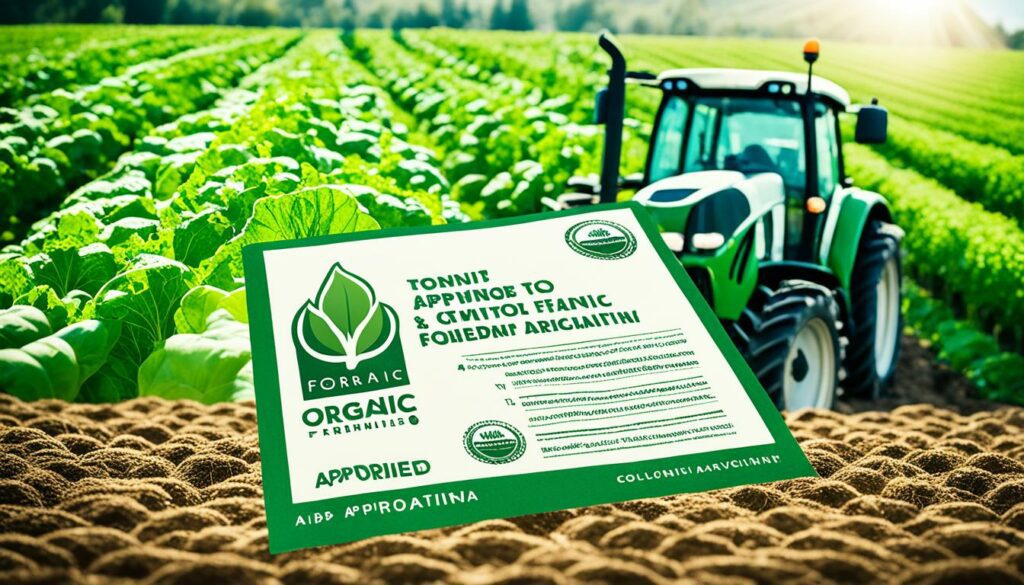
The Organic Agriculture Research and Extension Initiative (OREI) is a key programme. It gets about $50 million each year. OREI works to make organic agriculture better. It looks at areas like biology, farming techniques, and the environment. It also helps organic farming to connect globally.
The Organic Transitions programme (ORG) is important too. It gets about $7.5 million every year. ORG helps farmers switch to organic practices. It tackles problems like controlling diseases and pests. Schools and colleges also get support from this programme. They do research to improve the organic farming sector.
In 2021, American farmers earned $11.2 billion from selling organic products. This shows how big the organic farming industry is becoming. There are 17,445 certified organic farms in the U.S. The USDA also started helping small and medium farmers in five states. These farmers are working to reach high production and safety standards.
The NIFA agency is also important in supporting organic agriculture. It helps with funding for research and education. It runs competitive programmes like SARE, SBIR, and BFRDP. These help develop new ideas and technology in organic farming.
In the 2011-2012 school year, the USDA gave $10 million to Farm to School grants. This supported buying local food. Over 10,000 high tunnels have been set up since 2010. This supports the growth of organic plants.
The organic farming sector is growing quickly in the U.S. There is more demand for organic products. So, the USDA is investing $300 million in an initiative. This initiative will help farmers switch to organic methods more easily.
The USDA microloans have been very helpful for new farmers. Over 8,400 of these loans have been given out since 2013. Seventy percent of them went to new farmers. This shows that the support for starting organic farming is crucial.
All these investments and supports are key. They help the organic farming sector to grow. This way, U.S. farmers can meet the growing consumer demand for organic products.
The Specialty Crop Block Grant Programme (SCBGP) helps farmers and groups in the U.S. It works to make sure that special crops have a strong place in the market. Starting in 2006, the programme has really boosted the sector. It has invested over $500 million to make these key crops, such as fruits, vegetables, and tree nuts, more competitive. Since the 2018 Farm Bill, a big $85 million is available each year to keep the programme going strong.
To apply for these grants, you must grow specific crops. These crops include fruits, vegetables, and tree nuts. The projects funded by the SCBGP should aim to make crops more competitive. They can also join forces with other states through the Specialty Crop Multi-State subprogramme (SCMP). In SCMP projects, there must be partners from different states. Partners can be state agriculture departments, universities, producer groups, or non-profits. This helps share knowledge and resources among states.
The fundings for crop improvement have grown a lot. For example, in 2018, there were 788 projects funded all across the U.S. Each project had to show how it would improve crop competitiveness. The states get money based on their proposal’s quality. They can get at least $100,000 or a certain part of the total money. This depends on how good their grant application is.
If you’re in Oregon and have questions about applying, contact Gabrielle Ugalde. You can reach her at 503-986-6473 or at another number, 541-913-3440.
The COVID-19 pandemic changed a lot for farmers. The USDA worked hard to help them. It made sure they got the help they needed to stay strong.
The Coronavirus Food Assistance Program (CFAP) was a big help. It helped farmers hit hard by the virus. Another key programme, CFAP 2, ended on October 12, 2021. There was also help for livestock farmers and those in the timber business. These programmes ended in October 2021 too.
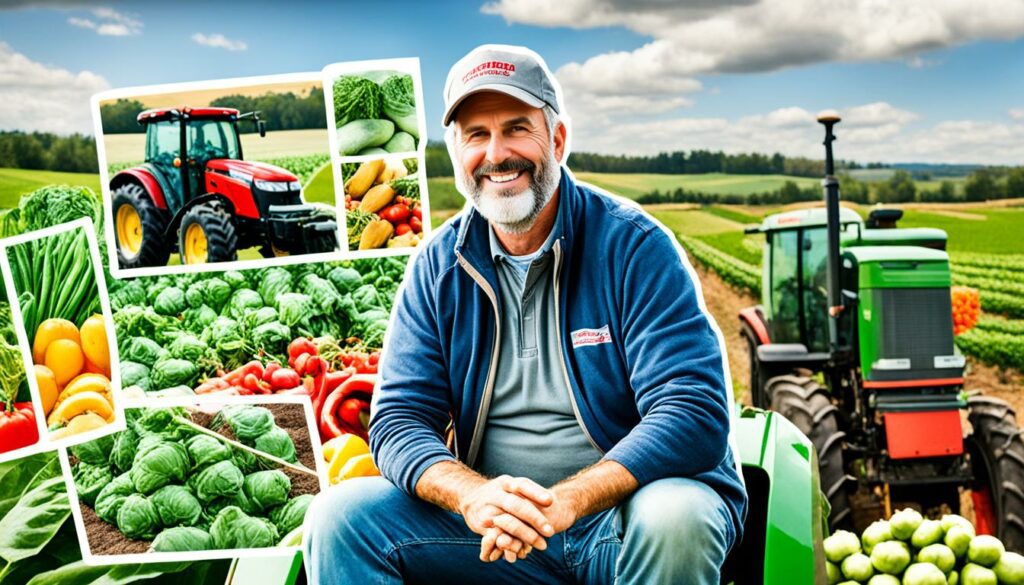
Organic dairy farmers got help too. They could join the Organic Dairy Marketing Assistance Program (ODMAP) until August 11, 2023. Another programme, the Pandemic Cover Crop Program, gave its help until March 15, 2022.
There were also plans for long-term help. The Pandemic Assistance Revenue Program (PARP) was one of these. It took applications from January 23, 2023, to July 14, 2023. This program helped with money to make up for lost earnings.
| Program | Application Period |
|---|---|
| Organic Dairy Marketing Assistance Program (ODMAP) | May 24, 2023 – August 11, 2023 |
| Pandemic Assistance Revenue Program (PARP) | January 23, 2023 – July 14, 2023 |
| Commodity Container Assistance Program (CCAP) | March 1, 2022 – January 31, 2023 |
The USDA also set up the Commodity Container Assistance Program (CCAP). It allowed applications until January 31, 2023. All these efforts show the USDA’s strong commitment. It aimed to help farmers through the pandemic and after.
Farm risk management is vital in today’s farming world. The Risk Management Agency (RMA) offers resources to help farmers. These tools lessen risks and aid in smart decision-making.
These programmes are key for economic stability for farmers. They provide financial help so producers can face risks and keep their farms running smoothly, even in hard times.
Making rural areas thrive takes a lot of work and strong support systems. It’s vital to have enough rural housing support together with funds for improving infrastructure. Doing this enhances life quality in these places.
The USDA is key in giving homeownership chances to low- and moderate-income rural folk. They offer various loan, grant, and guarantee schemes. This helps families own homes and fix them up. The efforts also reach those needing to rent. For example, there are USDA housing programs for the elderly and disabled too. This is important since about three in ten rural homes in the U.S. can’t afford housing. The USDA also helps new farmers and ranchers, boosting agriculture.

The USDA doesn’t stop at homes. They also back community facilities to boost the area’s growth. By supporting projects for infrastructure, utilities, business, and services, rural living becomes better. For instance, the Section 515 program is helping over 3,668 places and proves the USDA’s lasting rural aim.
Plus, they offer community development loans to improve or build important facilities. This strengthens rural community ties, ensuring everyone from homeowners to towns can thrive.
The USDA supports farmers with a variety of welfare programs. These aim to help farmers face challenges and increase their productivity. They offer financial help, support during disasters, and more. Let’s look at these important programs and how farmers can use them.
Using the USDA’s farmer welfare programs is easy. Farmers can go to their local USDA Service Centre. They’ll get help with understanding what they can apply for.
Also, the USDA website has lots of information and application forms for these programs. This makes sure all farmers can stay supported. It helps them deal with challenges in their farming businesses.
The US government’s approach to farming is key to stable food supplies and safe farming. With farming moving towards a more open market, the way aid is given must change too. This is to help with challenges now and in the future. These changes are crucial as they help deal with ups and downs in food production, especially for those who have had to move.
Creating a sustainable farming policy means more than just giving money. It’s about working together with different groups in the country and around the world. We can learn from reports and studies on farming lands and crops by the FAO. Especially, focusing on managing seed supplies better can help fight food insecurity.
Financial help for farm products like corn, wheat, and soybeans is important to keep markets steady. But, there isn’t as much help for special crops. Fixing this is vital for a fairer support system for all farmers. It’s time to connect different fields like energy and fishing with farming. By doing this, we ensure our food is safe and our countryside grows strong.
The government supports farmers in many ways. This includes farm loans, crop insurance, and subsidies. There are also grants and initiatives to improve farms and rural areas.
State support is vital for a steady food supply and rural growth. It helps farmers deal with risks, enhance their farms, and compete. This is important in local and global markets.
The US has a history of policies to keep farm incomes stable. The USDA and other agencies have shaped this. These policies help meet changing agricultural needs.
The US offers various subsidies to farmers. These include money directly, insurance for crops, and help to sell products better. The aim is stable income for farmers.
Subsidies help farmers financially. They make investments easier and lessen business risks. This support aims for long-term success in farming.
Farmers can get grants for farm needs and improvements. These include grants from the USDA’s Farm Service Agency. They are a big help for many farmers.
Applying for farming grants is straightforward. The FSA makes it easy, especially for small farms and new farmers. All farmers should check if they qualify.
For rural growth, there are loans and backing for businesses. Also, support for renewable energy, coop making, and creating new homes. These aim to boost life in countryside areas.
The USDA offers loans to smaller farms and ranches, mainly for first-time owners. It helps greatly with financial challenges in farming.
To get help, farmers should show they can’t get enough credit from banks. This ensures those who need it most can access these programs.
Crop insurance shields farmers from bad weather and market ups and downs. It makes sure insurance is not too expensive, providing a key safety net.
Farmers can join the insurance subsidy programs through approved providers. The Risk Management Agency helps with the rates and rules.
Today’s policies help farmers access markets and innovate. They also help ensure a stable future through USDA programs and actions.
These policies make farmers more resilient and competitive. They offer financial and market support, pushing for sustainable and successful farming.
The US gives support for organic farming through funds for certification and market growth. This encourages more farmers to go organic.
The SCBGP gives money for projects to make certain crops more competitive. It’s for crops like fruits and vegetables, with specific rules for joining.
Farmers can get COVID-19 relief through the CFAP. This program helps cover pandemic disruptions and extra expenses.
Long-term help includes ongoing money, risk tools, and learning programs. These are key to keeping farms prosperous and sustainable.
The Risk Management Agency provides tips, compliance help, and insurance. These resources help farmers lessen and deal with risks smartly.
Support is there for rural homes for low and middle income families. It also funds necessary community buildings for better rural living.
Welfare programs help farmers’ health by giving aid and ensuring supply chains work well. The USDA offers these crucial benefits and services.